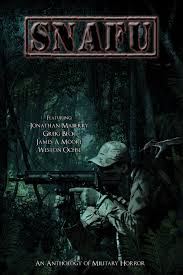
Edited by Geoff Brown and Amanda J. Spedding
Cohesion Press, 2014
eBook
Reviewed by Michael R. Collings
“Military horror.”
The phrase seems almost as tiredly redundant as the time-worn joke about “military intelligence” is oxymoronic. After all, by its nature, the military is expected to deal with horrific things. That is a given.
But when the already difficult and dangerous job of soldiering meets…well, other things, the term “military horror” takes on entirely new meanings.
SNAFU collects seventeen thrillers, tales in which otherwise deadly military operations ramp up even further with the addition of the outré, the mabacre, the un expected, and whole ranges of things bloody and gruesome. To increase the interest, settings range from 48,000 BC to 50,000AD; from nineteenth-century India to the twenty-first-century Pacific Northwest; from the coast of Japan during World War II to the scene of battle in the Civil War; from San Francisco in the 1960s to Berlin in the…well, you get the idea.
Let’s look briefly at a few of my favorite offerings (although by rights I should list every story in the book):
- Neal F. Litherland, “Blackwater”: A highly trained unit is sent into the small coastal village of Fisher’s Cove to rescue a kidnapped woman; when they see an ancient tome with the title The Esoteric Order of Dagon, it is a sign that their task is about to become infinitely more complicated;
- Christine Morgan, “Little Johnny Jump-Up”: A gentle (if that is the right word) Civil War ghost tale about the eerie relationship between a small boy, accidentally killed in the field, and a 6-pound cannon, and how that relationship impacts each member of the patrol;
- Brian W. Taylor, “Covert Genesis”: When a C-14 transport is shot down by something, the survivors don’t expect fellow survivors to suddenly undergo changes in eye color and have their skin begin to ripple as if there were something underneath—and even worse, there is;
- Jonathan Maberry, “Bug Hunt: A Joe Ledger Adventure”: What happens when one extraction team runs afoul of another such team…from somewhere else; an action-adventure tale featuring an already familiar hero and told with Maberry’s customary precision and verve;
- Weston Ochse, “Cold War Gothic”: On the eve of one of the 20th century’s greatest technological triumphs—the moon landing in 1969—Special Unit 77 combats aliens and supernatural forces in San Franisco…watch out especially for the Box Man (an extended experiment in ick) and the geisha vampires;
- Curtis C. Chen, “Making Waves”: When a magician teleports aboard an allied submarine off the coast of Japan during World War II, her objective is simple and direct—to awaken the Kraken hidden in the depths and thereby keep the Japanese too busy with defense to mount an offensive; the task becomes more intricate, however, when she discovers that instead of one Kraken, the area harbors two Elder Things;
- Greig Beck, “The Fossil”: A 100,000 year-long exploration of who—and what—are truly the aliens;
- Eric S. Brown, “Holding the Line”: In a phrase, prepare for the Sasquatch Apocalypse;
- Steve Ruthenbeck, “Ptearing All Before Us”: A small troop of infantry, assigned to being critical news to a commanding general during the 19th-century Indian Wars, abruptly encounter a nightmare from the native mythology, and one only is left alive to tell the tale;
- Kirsten Cross, “A Time of Blood”: Two British soldiers discover what lies beneath the foundations of Stonehenge, and they don’t much like what they find;
- James A. Moore, “Blank White Page”: Two strangers—one abnormally tall and gaunt, the other lean, continually smiling—ride into Silver Springs, Arizona, at the height of the silver rush; when their individual strangenesses mix with the boomtown atmosphere, the presence of a military detachment, and the arrival of revenge-seeking Apaches, things go south…a long way south, in a real hurry. This one is particularly intriguing for the tone, the dialogue between the two men that is constantly and purposively at odds with what happens around them.
Solid, every one of them.
If I have any objections to the stories, it would be that several just aren’t long enough. They read like chapters; they engage me with fascinating characters—both villains and heroes—follow exciting adventures, then concluded by intimating deeper problems, more dangerous situations…and I want to read more! Seems like a healthy objection to well-imagined tales.
Not one of the stories failed to attract and hold my interest. Not one of them failed to suggest new ways of looking and old monsters, and old ways of looking at new ones. It’s been a while since I’ve encountered a collection whose authors responded to the theme with such wholesale enthusiasm or one that so neatly defined and redefined its title: SNAFU.
Strongly recommended.








